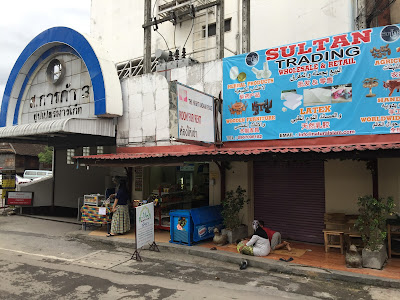Follow-up visits to the Ban Ho mosque: streets, conversations and Iftar
For the past three days (Tuesday-Thursday, June 12-14), I went back to the Ban Ho mosque repeatedly. I took a closer look around it, chatted with a few elderly people, and took part in break-fast dinner through their kind invitation.
Alleyway Scenes
This time, I entered the mosque from the other side of the alleyway, from the mosque's left to the right. The alleyway, I noticed, has clusters of restaurants, small shops, tourist agencies and more displays of historical narratives. (This reminded me of the streets near the Central Mosque in Seoul, in Itaewon district)
Displayed on one side of the alleyway are descriptions of the mosque's brief history in Thai, Arabic and Chinese (simplified) languages. It explains the comings and goings of Yunnanese Muslims as traders in the late nineteenth century on horse caravans, who carried commodities such as silk, tea and brass vessels and took back Thailand's raw cotton and salt. It further narrates the building of the mosque, the increase of people around the neighborhood following 1949, and expansion of the mosque in 1966. The Arabic text, interestingly, describes the migrants as muhajireen from Yunnan, and Yunnan Province itself as the home of the famous admiral Zheng He.
On the mosque's left are a few Halal restaurants, one of them being the highly-rated restaurant Khao Soi Islam. Needless to say, the food was delicious.
Across from the mosque were two or three more restaurants, a few stalls (that became more vibrant in the evening), and a few tourist agencies. The dates on the stalls, I was told, were from Indonesia. The stall even had halal Korean extra-spicy ramen.
While roaming around the mosque, I was fortunate to get into a conversation with an imam who had been walking out of a reading session of the Quran. The imam had come from Burma and had taught at the mosque for twenty years before returning to Burma five years ago. He was back at the Ban Ho mosque to offer help during the Ramadan. He traced his ancestral home to Weishan in Yunnan Province, and explained that seventy percent of the people who had migrated from Yunnan to Burma settled in Taunggyi (Southern Shan State). The rest of the traders/refugees settled in Lashio (Northern Shan State).
Migration routes of many of the Ban Ho community up to roughly the 1960s were spread out between Yunnan, Burma and northern Thailand. A sketch of traders and ex-KMT military personnel, both Muslim and non-Muslim, who had been active between Yunnan-Burma borderlands prior to 1950s and now became refugees in Thailand, can be found in Wang Liulan's article; a more complete version of the author's research is accessible here.
During the fifty years she has lived in Chiangmai, she has undertaken the pilgrimage (hajj) twice. The first time was in 1972, when she flew from Bangkok with her mother and spent time in Jeddah, Medina and Mecca for forty days. In Jeddah and Medina she stayed in the house of the Lin brothers, who had escaped from mainland China in 1949, sojourned briefly in Burma (in Lashio) and decided to settle in Jeddah. Her second pilgrimage was fairly recent, six years ago. One of the Lin brothers, whom I have been following for my dissertation, also visited Chiangmai on their way back to Jeddah when they traveled to Yunnan in the late 1980s after mainland China's external interactions resumed.
Iftar
Accompanied by her and the people she has generously introduced me, on Wednesday and Thursday evenings right before the 'Eid day, I sat inside the mosque's make-shift cafeteria where more than a hundred people gathered to break the fast. Two imams (one of them, someone informed me, was a Thai-Indian person) spoke for about twenty minutes in Thai before the maghrib prayers around 7 pm. Near the entry point was a donation box where I saw many people contribute small bills. I was a bit surprised to find that women and men sat together freely inside one common space for dining, which I so far have not seen in Taiwan or mainland China; sitting on the same tables were mostly families, I was told. Below are two images from the evening dinners.
The food for the lively iftar dinners in Ban Ho mosque were prepared inside the kitchen in the hall. I am not exactly sure about the origins of the cuisine. Thai-style Chinese food perhaps?
I was not able to be at the mosque on the 'Eid celebration day, but the iftar dinners offered glimpses into the vibrant communal life and also opportunities to connect with people who may be able to help me during my future potential trip to Mae Sai further north.












Comments
Post a Comment